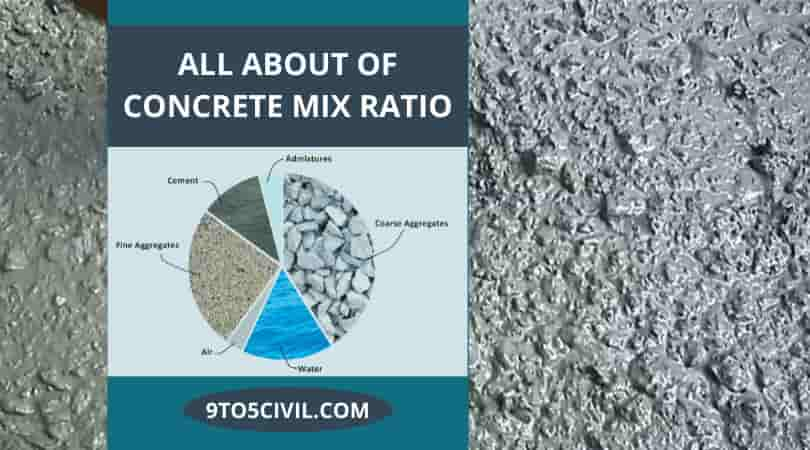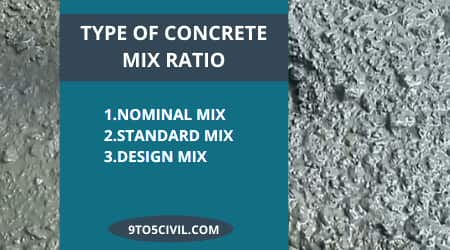
What Is a Concrete Mix Ratio?
The concrete mix ratio is a selection of the right component of concrete and determining the specific strength and durability of the concrete as economically as possible.
There are four main components for a mixture of concrete. These four components are cement, sand, aggregate, and admixture, respectively. Durability can be achieved according to ratio of the concrete mix these four components in the right proportions.
All concrete costs are based on two factors the cost of materials and the cost of labor. For good concrete and bad concrete, labor costs for formwork, batching, mixing, transportation and curing are almost the same. So the focus is mainly on the cost of the material.
The cost of cement is many times higher than the cost of other components, so it is mainly focused on using as little cement as possible with strength and durability.
Thus the concrete mix ratio is based on the quality of the material used in concrete and its proportions. The two essential components of concrete are aggregates and paste. The relationship between the two will be worth remembering.
The workability of mass is provided by the effect of the paste. This affects workability through the amount of paste and the thinning. The strength of the concrete depends on the strength of the paste. With rare exceptions, the strength of the mineral aggregate is stronger than the strength of the paste.
Type of Concrete Mix Ratio
Mix concrete ratio is the mixing of the components of concrete according to the strength of the structure. The types of concrete mix are given based on the requirement as follows.
1. Nominal Mix
In the past, the proportions of cement, fine and coarse aggregates for concrete were suggested. These mixtures of fixed cement-aggregate ratio were called trivial mixtures if they ensured sufficient strength.
The nominal mix is concrete that is prepared on the basis of experience without any quality. In this type of concrete, fine aggregate, coarse aggregate, and cement were prepared based on the weight of these three components.
According to is IS CODE 456-2000, the nominal mix includes M-5, M-7.5, M-10, M15, M20, etc.
Mixed ratio of concrete is used to build small houses in villages. In addition, the nominal mix is used in the footing and footing base.
| Normal Grade of Concrete | |||
| Concrete Grade | Compressive Strength | ||
| Concrete Grade | Mix Ratio | psi | MPa (N/mm2) |
| M5 | 1:5:10 | 725 psi | 5 MPa |
| M7.5 | 1:4:8 | 1087 psi | 7.5 MPa |
| M10 | 1:3:6 | 1450 psi | 10 MPa |
| M15 | 1:2:4 | 2175 psi | 15 MPa |
| M20 | 1:1.5:3 | 2900 psi | 20 MPa |
2. Standard Mix
The mixture of cement-aggregate ratio (by volume) is fixed, which varies according to the change in power. It can also be mixed with high strength. For this reason, specifications are involved in obtaining minimal compressive strength. This type of mixture is called a standard mixture.
The standard mix consists of M25, M30, M40, M45, etc.
Standard Grade of Concrete
| Concrete Grade | Compressive Strength | ||
| Concrete Grade | Mix Ratio | MPa (N/mm2) | psi |
| M25 | 1:1:2 | 25 MPa | 3625 psi |
| M30 | Design Mix | 30 MPa | 4350 psi |
| M35 | Design Mix | 35 MPa | 5075 psi |
| M40 | Design Mix | 40 MPa | 5800 psi |
| M45 | Design Mix | 45 MPa | 6525 psi |
3. Design Mix
Designing for concrete used in construction on site is done keeping in mind its workability, strength, durability, etc.
Its quality is also taken into consideration while designing concrete. For the design mix, the first different concrete mix is prepared and tested in the laboratory.
Design mix is done keeping in mind various factors. Such as aggregate content, grading, water content, cement content, etc., are taken into consideration.
The sample thus prepared is tested in the laboratory, and the result is modified into concrete as required. The strength of concrete obtained in the laboratory is compared to the strength of concrete found at the site by the following formula.
F’ck = fck +tS
where F’ck = Target mean strength
fck = characteristic strength
t = constant
S= standard deviation.
The standard mix consists of M50, M55, M60, M65, M70, etc.
High Strength Concrete Grades
| Concrete Grade | Compressive Strength | ||
| Concrete Grade | Mix Ratio | MPa (N/mm2) | psi |
| M50 | Design Mix | 50 MPa | 7250 psi |
| M55 | Design Mix | 55 MPa | 7975 psi |
| M60 | Design Mix | 60 MPa | 8700 psi |
| M65 | Design Mix | 65 MPa | 9425 psi |
| M70 | Design Mix | 70 MPa | 10150 psi |
Factor Affecting of Concrete Mix Ratio
The factors affecting the mix of concrete are as follows
- Grade of Concrete
- Type of Cement
- Maximum Nominal Size of Aggregates
- Workability
- Durability
- Quality Control
1. Grade of Concrete
The grade of concrete represents the characteristic compressive strength of concrete. Its compressive strength value is a value that does not exceed 5% of the test result of the strength of the concrete cube.
The value of the strength of concrete at the site is kept higher than the target mean strength.
F’ck = fck +tS
2. Type of Cement
The strength of concrete depends on the cement. High strength portland cement should be used where high strength is required.
Rapid hardening cement should be used where strength is to be obtained soon. Where the heat of hydration is to be reduced, low heat cement should be used.
3. Maximum Nominal Size of Aggregates
The maximum aggregate size in concrete is determined from sieve analysis. The larger the size of the aggregate, the less they need for cement pests. In addition, as the size of the aggregate increases, so does the workability.
Thus, as the need for cement pest increases, the compressive strength of concrete increases. Generally, aggregates of 10mm and 20mm size should be used to obtain high-strength concrete.
4. Water cement ratio
The water/cement ratio is directly related to the compressive strength of concrete.
As the water/cement ratio increases, the compressive strength of concrete decreases. Similarly, as the water/cement ratio decreases, the compressive strength of concrete increases.
5. Workability
The workability of concrete depends on the various processes of concrete. The main principle of concrete mix design is to achieve the workability of concrete.
Concrete should be completely compaction to get the workability of concrete
6. Durability
As the permeability of concrete increases, the durability of concrete decreases. In addition, the water/cement ratio in concrete directly affects the permeability of concrete Therefore the water/cement ratio of concrete should be limited to 0.45 to 0.55.
In addition, the durability of concrete should be according to the location of the concrete.
7. Quality Control
When making concrete, a slump test should be done at each batch of concrete. So that the workability of concrete is maintained.
The quality of concrete components should be good. Supervision of concrete is essential during concreting.
Like this post? Share it with your friends!
Suggested Read –
- What is Flight of Stair? | Requirement of Good Stair | Type of stair
- What are Traps? | Specification of Plumbing Trap | 14 Types of Traps in Plumbing
- What Is Floating Slab? | Purpose of Floating Slab | Construction of Floating Slab | Advantage & Disadvantage of Floating Slab
- What Is Monolithic Slab? | What Is Floating Slab? | Monolithic Slab Vs Floating Slab
- Stained Concrete Floors Pros and Cons
- How to Get Stamped Concrete Over Existing Concrete?
- 8 Types of Concrete Finishes | 14 Types of Concrete Finishes for Driveways
- Cinder Block Vs Concrete Block | 11 Type of Concrete Block
- Salt Finish Concrete Pros and Cons
- How Much Does Gutter Replacement Cost?
- Best Gutter Downspout Extension Ideas
- 12 Gutter Drainage Solutions
What Is a Concrete Mix Design?
Concrete mix design involves a process of preparation in which a mix of ingredients creates the required strength and durability for the concrete structure. Because every ingredient in the mix consists of different properties, it’s not an easy task to create a great concrete mix.
What Is the Standard Concrete Design Mix?
A properly designed concrete mixture will possess the desired workability for fresh concrete and the required durability and strength for hardened concrete. Typically, the volume of a mix is about 10 to 15% cementitious material, 60 to 75% aggregate, and 15 to 20% water.
What Is a Good Concrete Mix Design?
A normal-performance concrete mix has a performance strength ranging between 20 and 40 MPa. It is the more used mix of the two. Normal-performance concrete has good workability if all of the mix ingredients are in accurate proportions.
What Are the Different Concrete Mix Design?
Types of Concrete Mix Design
- Nominal Concrete Mix:
- Designed Concrete Mix:
- Standard Mix:
What Are the 4 Standard Concrete Mixes?
There are only four fundamental ingredients in concrete: cement, aggregate, sand, and water, but each serves a particular purpose. Understanding the purpose of each ingredient is key to determining what concrete mix proportions are best in a given situation.
What Is the Mixture for Concrete?
In terms of the ratio for concrete, it depends on what strength you are trying to achieve, but as a general guide a standard concrete mix would be 1 part cement to 2 parts sand to 4 parts aggregates. For foundations, a mix of 1 part cement to 3 parts sand to 6 parts aggregates can be used.
What Is the Best Concrete Mixing Ratio?
The 1-2-3 concrete mix ratio is considered the “classic” mix ratio by many professional builders. That is because it is among the most versatile mix ratios, regardless of what scale it is being used at. As such, it can productively be used in a wide variety of weight-bearing projects. The 1-2-3 ratio’s makeup is described right in its name.
 Skip to content
Skip to content
